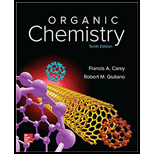
Concept explainers
Interpretation:
The resonance structures for the given Lewis formulas are to be written by curved arrows and the stabilities of two Lewis formulas are to be compared and the more stable structure, if any, is to be identified.
Concept introduction:
Maximizing the number of bonds and obey the octet rule are the main factors that contribute to the stability of a resonance structure.
When two or more Lewis structure satisfy the octet rule, the structure which have the smallest charge separation is the major contributor.
Among all Lewis structural formulas that satisfy the octet rule, and in which one or more atoms bears the formal charge. The major contributor structure is one in which have the negative charge on the most electronegative atom.
Want to see the full answer?
Check out a sample textbook solution
Chapter 1 Solutions
ORGANIC CHEMISTRY-PACKAGE >CUSTOM<
- Write the resonance structure that would result from moving the electrons in the wayindicated by the curved arrows.arrow_forwardSome of the figures represent invalid sets of resonance structures for this molecule. Select all the VALID sets of resonance structures.arrow_forwardWrite the resonance structure that would result from moving the electrons in the way indicated by the curved arrows.arrow_forward
- Why does the bond dipole point towards the more electronegative atom? Why does it accumulate a partial negative charge?arrow_forwardDetermin the total number of resonance structures for the following image below?arrow_forwardDescribe the difference between a full Lewis structure and bond-line notation. What changes? Why is it easier to write?Dontarrow_forward
- Draw the bond-line formula for the given compounds. am i correct? if not, what are the right bond-line formulas?arrow_forwarda.)Draw a Lewis diagram for POBr3 in which all atoms have a formal charge of zero . b.)Draw a Lewis structure for POBr3 in which the octet rule is satisfied on all atoms and show all NONZERO formal charges on all atoms. c.)Based on formal charge, which is the best Lewis structure for the molecule?octet rule satisfied for all atoms or smallest formal chargearrow_forwarda) Draw the formal charges to the molecule below. Label atleast two functional groups found in this molecule. Identify and circle the π bonds. b) Draw a curly arrow notation to show how the electrons are redistributed to show a new resonance structure in which the formal charge has moved to a different heteroatom.arrow_forward
- Draw three valid Lewis structures for the SiPSH (connected Si-P-S-H) that obey the octet rule and write any non-zero formal charges above the structures and circle the best structure.arrow_forwardIs this a valid resonance structure? why or why not. (the bond is moved to the left) forgot to include arrowthank you for your time.arrow_forwardWhat is the structural diagram of CH2ClF without lone pairs? Also what is its Electronegativity bond after you subtract the smaller from the greater value along with its bond type, total lone pairs of electrons and total bonding pairs of electrons? Lastly, is it polar or non polar (polar molecularity) ?arrow_forward

 Organic Chemistry: A Guided InquiryChemistryISBN:9780618974122Author:Andrei StraumanisPublisher:Cengage Learning
Organic Chemistry: A Guided InquiryChemistryISBN:9780618974122Author:Andrei StraumanisPublisher:Cengage Learning Introductory Chemistry: An Active Learning Approa...ChemistryISBN:9781305079250Author:Mark S. Cracolice, Ed PetersPublisher:Cengage Learning
Introductory Chemistry: An Active Learning Approa...ChemistryISBN:9781305079250Author:Mark S. Cracolice, Ed PetersPublisher:Cengage Learning- Chemistry: Matter and ChangeChemistryISBN:9780078746376Author:Dinah Zike, Laurel Dingrando, Nicholas Hainen, Cheryl WistromPublisher:Glencoe/McGraw-Hill School Pub Co



